The concept of shipping container homes has been gaining traction as a practical solution to affordable housing challenges. These homes, constructed from repurposed shipping containers, have emerged as a viable option for those looking to downsize or minimize their living expenses.
Adaptable and relatively low-cost compared to traditional construction, such homes offer a form of alternative living space that can be both stylish and functional.
While initially used as makeshift solutions for temporary housing needs, today’s shipping container homes have evolved to include modern amenities and innovative designs.
In exploring the cheapest container home options, it is essential to consider the balance between cost and quality. Affordability doesn’t need to compromise comfort or aesthetic appeal.
Many companies specialize in transforming these steel structures into fully habitable spaces equipped with electricity, plumbing, HVAC systems, and insulation.
With options ranging from simple, single-unit dwellings to larger, multi-story houses, the flexibility of shipping container architecture allows for personalized spaces tailored to individual budgets and preferences.
The attractiveness of shipping container homes lies not just in their price point, but also in the speed of construction and potential for customization.
Whether it’s a compact 20-foot tiny home or a spacious 40-foot residence, these cost-effective alternatives to conventional homes continue to inspire creatives and eco-conscious individuals seeking a unique and sustainable place to live.
With a growing number of manufacturers, the market for container homes is becoming increasingly accessible, offering various options for those interested in this modern approach to housing.
Cost Analysis
When considering a shipping container home, the financial aspect is crucial. This section provides a detailed breakdown of what to expect with respect to costs and a thoughtful approach to budget.
Budgeting for a Container Home
A critical first step in creating an affordable container home is to establish a realistic budget. Prospective homeowners may find that a prefab container home typically costs between $120 to $300 per square foot, while custom-designed ones increase to $250 to $400+ per square foot. These costs can scale depending on the size, design complexity, and the quality of finishes chosen. To ensure affordability, one must account for all expenses, including:
- Land acquisition: Price varies by location
- Container purchase: Ranging from a few thousand dollars per unit
- Site preparation: Including foundation and utility connections
- Construction: Including insulation, framing, and interior finishes
- Permitting and fees: Variable by municipality
Understanding the Total Investment
The total investment in a shipping container home is not just in its initial construction but also in its long-term value. While the single container models cost approximately $25,000 to $80,000, a multi-container setup can fall between $80,000 to $250,000. Beyond the sticker price, the investment also includes:
- Durability: Shipping containers are robust and can last for decades.
- Customization: The potential for a personalized space adds value.
- Energy efficiency: Properly insulated containers can be cost-effective in operation.
- Luxury enhancements: High-end finishes and technology can transform a shipping container cabin into a luxury dwelling, albeit at a higher cost.
It’s pertinent to note that while these homes can be a more affordable option compared to traditional construction, the cost can vary widely based on location, design, and materials. Careful consideration during the planning phase can lead to significant cost savings and a cost-effective home.
Building Your Container Home
When considering the construction of a container home, potential homeowners weigh the significance of cost effectiveness, sustainability, and customization. Making the right decisions during the building process can lead to significant savings and an environmentally friendly dwelling.
DIY vs. Professional Builds
DIY (Do It Yourself) projects appeal to those hoping to minimize costs and apply a personal touch to their container homes.
By undertaking the construction themselves, individuals can control expenses more directly, especially when it comes to interiors like installing a wood-burning stove for heating.
DIY builders often opt for reclaimed materials, such as wood or metal, adding to the eco-friendly nature of their homes. However, key considerations include having the skills to ensure the structural integrity of the home, and knowledge of how to integrate systems like water, electricity, and sewage safely and efficiently.
In contrast, Professional Builds usually involve working with a company specializing in prefab or customized container homes, like TAYNR shipping container homes.
These homes often come with all the essentials already installed, including modern amenities and utilities. Professionals ensure that the home is built to code, with proper insulation, ventilation, and the potential inclusion of solar panels for energy efficiency.
While upfront costs for professional builds are higher, the expertise provided can prevent costly mistakes and ensure the home is durable and complies with local building regulations.
When considering the construction of a cost-effective container home, prospective homeowners have a range of builders to choose from.
Below is a curated list detailing some notable firms in this specialized sector:
- Custom Container Living: This company stands out for its offerings in family container homes. They provide custom designs tailored to different family sizes and preferences.
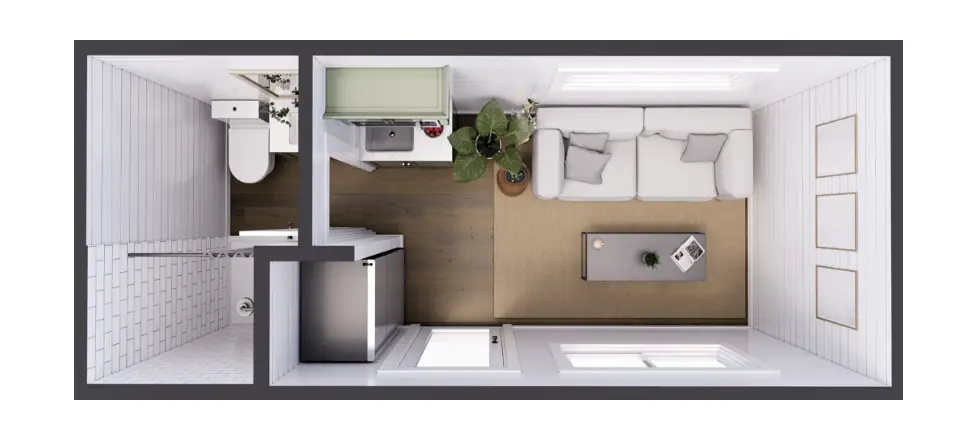
Starting At: $44,900
- Honomobo: Known for their sleek and modern container home designs, Honomobo combines style with the simplicity of container home living.
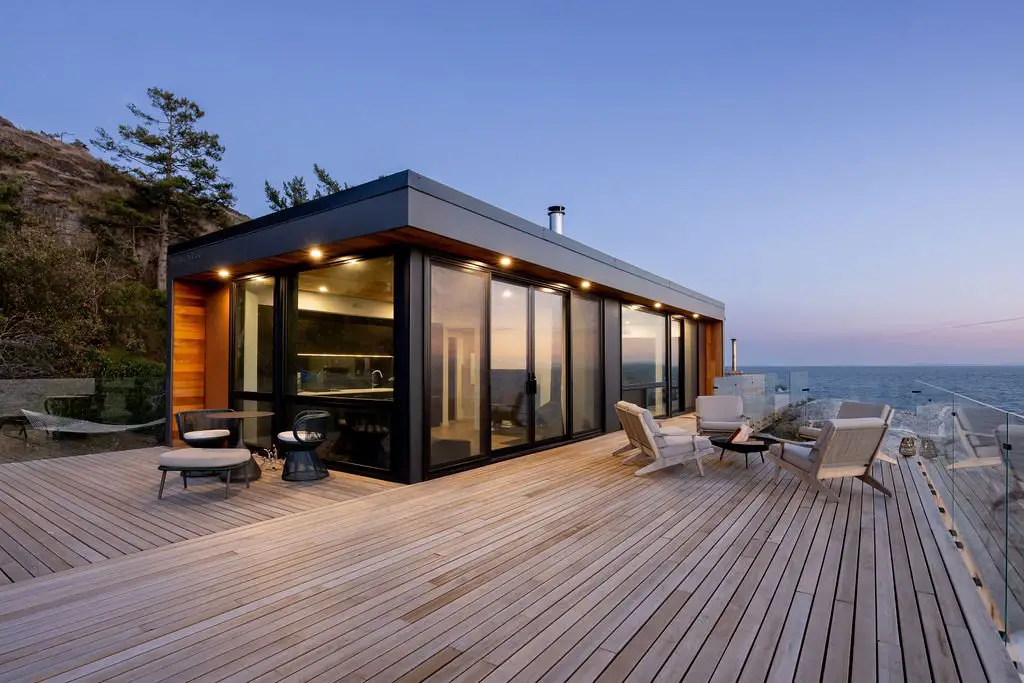
2 BED 1 BATH | 640 SQ. FEET | STARTING AT $215,150 USD
- Alternative Living Spaces: They are praised for the versatility of their tiny container homes, making them a go-to for those who wish to dwell in compact spaces.
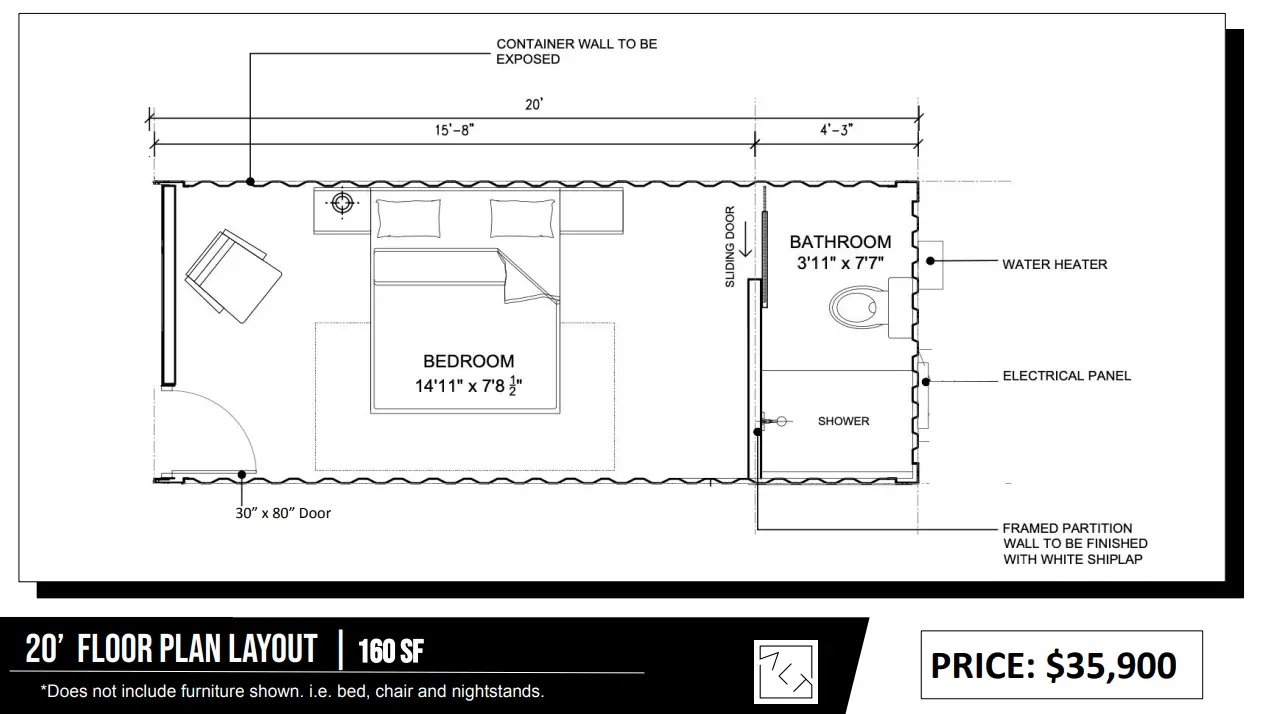
- Backcountry Containers: Their portfolio includes a range of container homes, from basic to family-oriented structures, reflecting their expertise in personalizing homes to client needs.
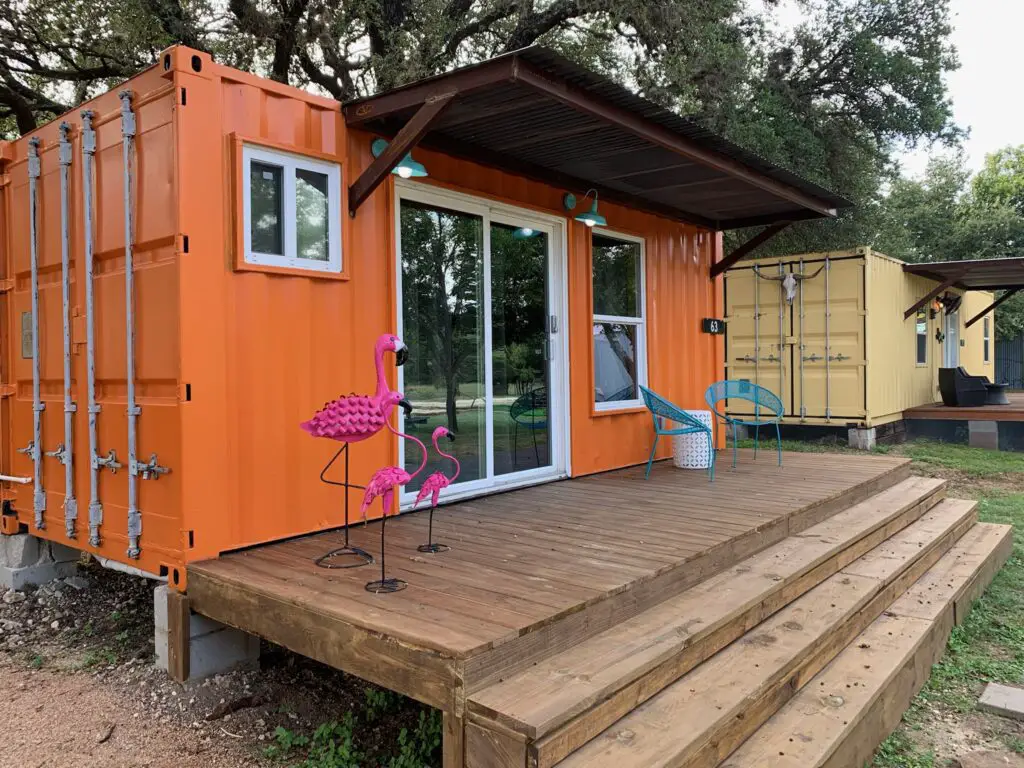
The Ezra Price starting at: $54,000
- Bob’s Containers: Offering a selection of container homes, including a 40 ft luxury model, they cater to a variety of living situations and preferences.
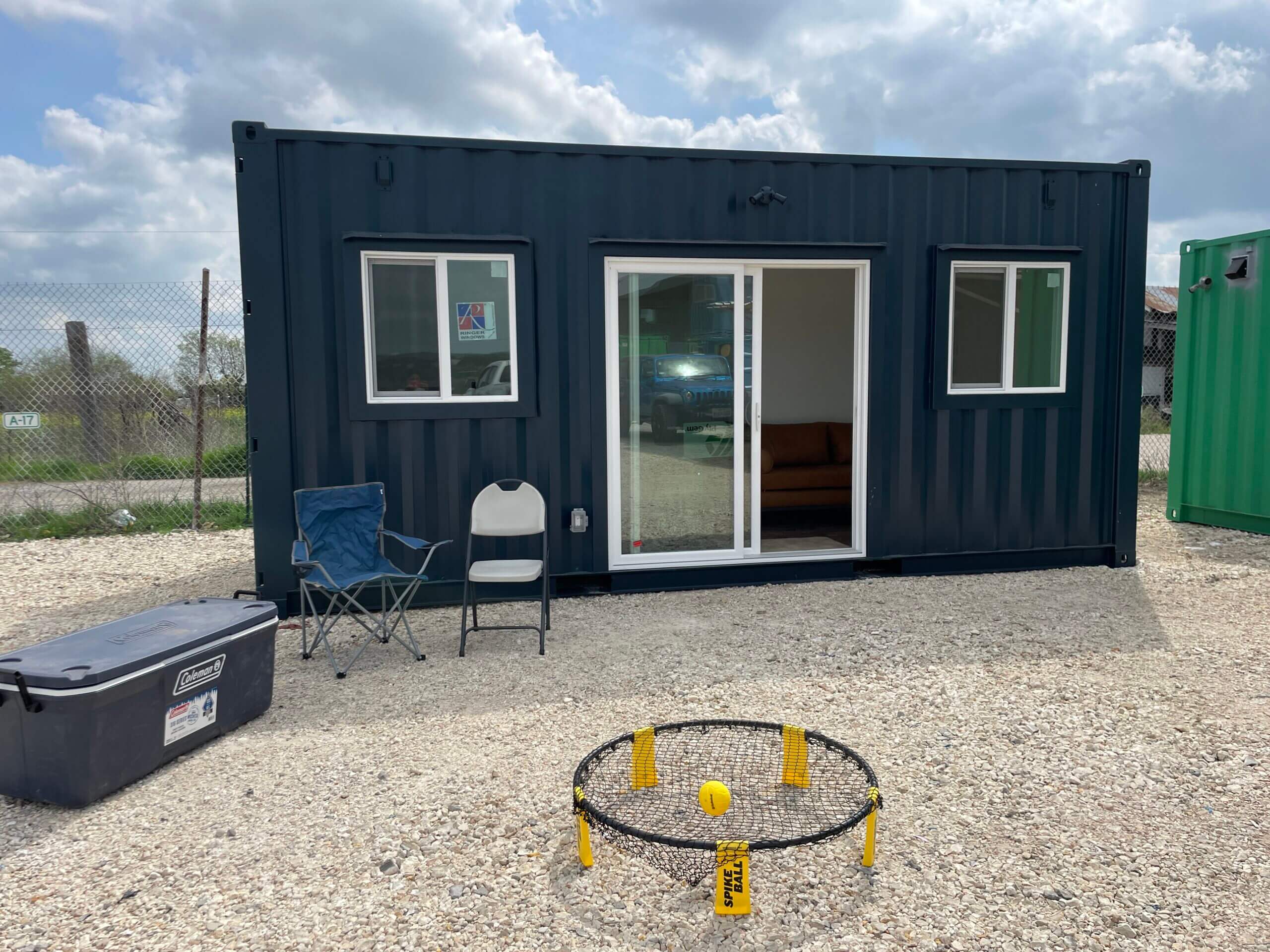
THE ABILENE STARTING AT $45,357
These builders are equipped to provide a unique blend of affordability and customized living solutions. They each have a distinctive approach to creating container homes, which enables clients to find a match that suits their specific requirements and budget constraints.
Case Studies and Examples
Exploring real-life container home projects reveals not only the cost-effectiveness of this innovative housing solution but also the creativity and customization that homeowners bring to their builds. These case studies spotlight specific examples of affordability paired with personal ingenuity.
Successful Container Home Projects
- Joseph Dupuis’ Container Home: Dubbed a triumph in minimalistic living, Joseph Dupuis constructed a functional residence using three shipping containers, achieving a remarkable feat in cost-efficiency with a build cost of just $20,000. His approach demonstrates how sustainable design principles can mesh with budget-friendly objectives.
- Containers of Hope: Designed by Benjamin Garcia Saxe, Containers of Hope is an iconic project, recognized for its surprisingly low budget of $40,000. The home showcases an innovative use of two shipping containers, redesigned to create a comfortable space, emphasizing natural light and ventilation.
Individual Innovations
- Honomobo: Operating at the intersection of style and functionality, Honomobo units are prefabricated homes crafted from shipping containers. They have earned acclaim for their sleek, modern designs and the ability to be placed on a foundation or used as an addition to existing properties.
- Backcountry Containers: Offering a range of custom designs, Backcountry Containers specializes in transforming shipping containers into unique homes that reflect the owner’s personality while prioritizing affordability.
- Larry Wade’s Taj Malodge: For a mere total cost after finishing, Larry Wade has created the Taj Malodge, a container home project that exemplifies DIY spirit and economy. Starting with a used shipping container, Larry’s endeavor reflects a frugal yet functional approach to container home construction.
By examining these diverse projects, one can appreciate the cost-effective potential and customizability that shipping container homes offer. Whether through the lens of a DIY builder like Joseph Dupuis or the refined designs of companies like Honomobo, one thing is consistent: a container home can achieve savings without sacrificing quality or personal expression.
Future of Container Homes
The container home trend has grown significantly, with advances in design and affordability positioning it as a potential solution to housing shortages.
Evolution of Design and Technology
Container homes have transitioned from basic Tin Can Cabins to more complex, modular housing solutions. Design techniques have evolved to include multi-story and multi-unit dwellings that are both stylish and functional.
Integration of green technologies such as solar panels and rainwater harvesting systems is becoming commonplace, enhancing the sustainability of these structures.
Companies like IQ Container Homes demonstrate that container homes can be both environmentally friendly and aesthetically pleasing.
Technology plays a pivotal role in the construction of container homes. Advances in insulation and structural reinforcement make these homes more durable and comfortable.
Impact on Affordable Home Market
Container homes have the potential to significantly impact the affordable home market. Their relatively low cost of acquisition and conversion into livable spaces makes them an ideal choice for those seeking an affordable tiny home. The cost-efficiency of container homes is amplified by their modular nature, which allows for mass production and customization.
As demand for economical housing options persists, container homes stand out as a viable solution. They utilize existing materials, often surplus containers, and transform them into comfortable living spaces. This efficient use of resources reflects a shift in the housing market toward more scalable and affordable housing strategies that can address various socioeconomic challenges.
